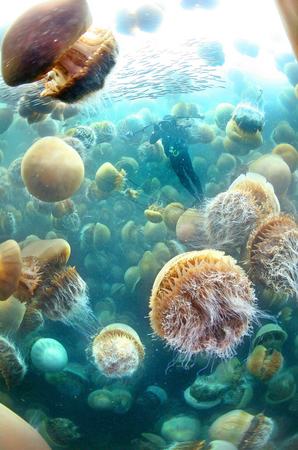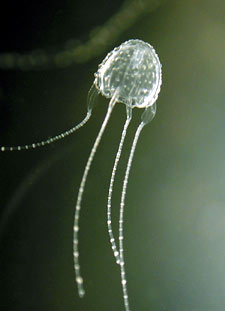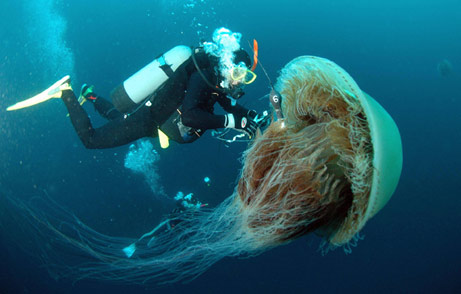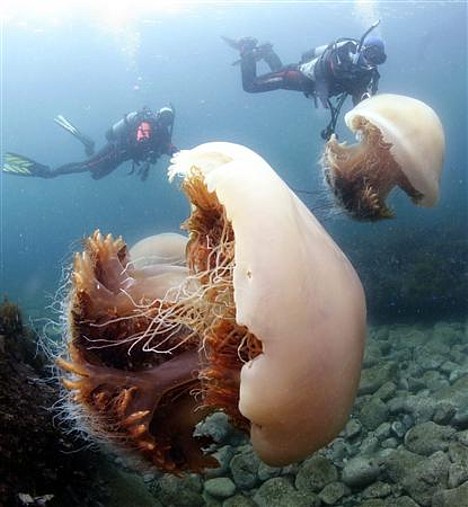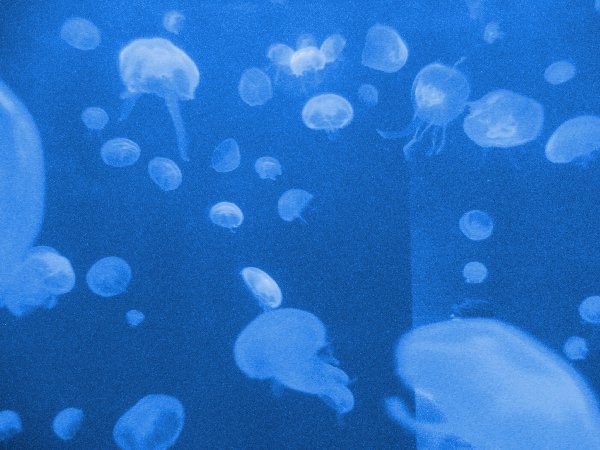|
|
|||||||||||||||||||||||||||||||
|
Jellyfish Swarms feeding on Polluted Waters
Climate Change and Pollution causing Jellyfish SwarmsBy Suzanne MacNevin - February 2008. Across the Earth's oceans trillions of jellyfish are on the move, building in huge swarms. In Japan, the government and fishermen are fighting back, killing jellyfish by the thousands but more just keep appearing. Jellyfish are attracted to polluted waters around Tokyo harbour, Sydney Australia, Miami Florida and every coastal city around the world. There the jellyfish can scavenge and feed on large numbers of dead fish and have little or no predators (very few fish eat jellyfish, which are highly toxic). Combined with climate change and warmer waters it has resulted in a sudden spike in jellyfish numbers, literally in the trillions, and it is causing havoc with the world's fishing industry. Jellyfish are semi-transparent and feed on other fish, scavenge food and using their poisonous tentacles to stun their prey. They are responsible for thousands of human deaths every year from their poisonous tentacles and those numbers are rising every year. There are about 70 different breeds of jellyfish that are poisonous to humans and they kill approx. 1000 times more frequently than all shark attacks combined. There is no all purpose anti-venom against jellyfish venom as it contains (usually) at least two or three different types of venom: Hemotoxin, which destroys blood cells and the heart (victims usually die due to cardiac arrest), a neurotoxin which attacks the brain, and a third toxin which attacks the nervous system, causing extreme pain and paralysis. The scary thing is jellyfish have existed on earth long before dinosaurs or humans did. They have evolved for millions of years, and contrary to popular belief, are not stupid or blind. They don't have a brain to store memories in, but instead do all their thinking with a "nerve net" located in its epidermis. They can sense their surroundings and some species can even see colour (and have 24 tiny sensory eyes) and are highly evolved to be both unedible and highly deadly.
The most deadly variety is the Irukandji jellyfish, which is originally from Australia but has since spread all over the globe. It is a very tiny jellyfish with 3 or 4 tentacles, but its venom makes it the most venomous creature in the world. There are several different subspecies, but all appear to be deadly. In recent years the numbers of jellyfish across the globe have been rising steadily, especially in areas where climate change and warmer waters has caused many fish to lose their habitats. The jellyfish, the great scavengers of the sea, have been eating the remains of these fish and growing in large numbers. So called "dead zones" near coastal cities where coral reefs have died off due to heavy water pollution has also caused jellyfish numbers to skyrocket, along with jellyfish related deaths. But the biggest problem, sorry to say it, is not the threat to human life. It is the threat to the world's fishing industry as swarms of jellyfish are now hunting in packs and taking down large numbers of fish. Because jellyfish are semi-transparent they can sneak up on fish cautiously, ensnare them in their poisonous tentacles and then dissolve their bodies in their stomachs within minutes. In Japan this plague of jellyfish is affecting the world's largest fishing industry as boats regularly keep catching jellyfish in their nets instead of actual fish (or both, but then the fish found is full of jellyfish venom and unedible). The Nomura's Jellyfish off the coast of Japan grows to be 2 meters (6 and a half feet) long, not counting their tentacles and weigh up to 500 pounds. According to estimates by the Japanese government this plague is 100 times the size of normal Nomura's Jellyfish populations and they are taking aggressive actions. The Japanese fishermen have taken to chopping up the jellyfish and dumping their bodies back into the sea, but the Japanese government has take it one step further to create a committee and a taskforce dedicated to hunting down, tracking and destroying jellyfish in order to protect the other fish that makes up their livelihood (much in the same way a shepherd would hunt wolves in order to protect his flock). This practice of chopping up jellyfish however might not be helping. The problem with combating the jellyfish is that when they are under attack or killed, they release millions of sperm or eggs each which connect in the water and attach to rocks or coral formations as polyps (baby jellyfish). When the water temperature changes the polyps detach from the sea floor and grow into more jellyfish. Thus all it takes is an ocean current of warm water caused by global warming and poof, millions of more jellyfish.
And this is happening all over the world. Europe's beaches has become the latest environmental hazard due to jellyfish. People heading for Mediterranean beaches are being warned to prepare for an unprecedented invasion of poisonous jellyfishes. Beaches are being closed and swimmers from Spain to Bulgaria have been stung. A tourist beach in Costa Blanca had 62 bathers stung in one day alone. During 2007 Europe had a very dry summer, breaking previous records, and rivers were running dry. Jellyfish dislike freshwater and normally stay away from coasts except during droughts, so the drought in 2007 caused a huge spike in jellyfish stings. While most species reaching European beaches aren't considered lethal to humans, some like the purple jellyfish have a very painful sting that can cause severe swelling and an allergic reaction. The Spanish Red Cross is reported to have treated more than 19,000 bathers in 2007 for jellyfish stings in the famous Costa Brava resort region alone. Health authorities estimate there was over 70,000 stings during 2007. In a normal year there is only about 6000 stings. The environmental group Oceana Europe, which campaigns to protect and restore the world's oceans, attributes the rise in the number of jellyfish to a combination of rise in water temperature because of climate change, pollution along the Europe's coasts and also highlights over-fishing of natural predators (such as tuna, swordfish, moonfish, triggerfish and certain kinds of sea turtles) that feed on jellyfish and keep their population under control. The group sent a research boat around Spain's coastal waters in 2007 and concluded that many beaches are suffering under an "invasion" of jellyfish. The director of research on Oceana's catamaran said: "We have found jellyfish all over the Mediterranean, but we've seen concentrations of more than 10 jellyfish per square metre. Wherever we look, there is practically nowhere without jellyfish."
Among the most notorious of jellyfish is the Portuguese Man of War (Physalia physalis), whose stings can produce painful burns for bathers and also lead to heart failure. Jellyfish spend most of their lives in the open seas, because that is where the water tends to be more saline and warmer. With climate change however the jellyfish are migrating with the warmer waters to areas which previously had no jellyfish and eating all the available fish. Researchers also believe the jellyfish approach beaches when water near the coast, which is generally colder and less saline, stops acting as a barrier. That has happened in many places as there is less freshwater entering the sea from rivers because of the drought. In Australia climate change has dramatically altered the ocean current flowing down Australia's east coast, sending water temperatures soaring, rearranging the distribution of sea life and making the water more acidic. By 2070, CSIRO marine biologists warned in 2007 Australia could have large numbers of box jellyfish wreaking havoc and posing a multibillion-dollar threat to "the economic and ecological sustainability of fisheries, aquaculture and tourism." Water temperatures off the coast of Australia have risen between 1 to 5 degrees Celsius in the last 60 years, an average of 2.1 degrees overall, with Tasmania's water temperatures rising at twice the rate.
The explanation was that climate change had increased the strength of the key current channelling warm water down from Queensland. "It is a clearly demonstrated change in the current," Dr Hobday said. The cause of the change could be the rise in greenhouse gases from human activity, the impact of the hole in the ozone layer, or both. Significant variations in east-coast marine biology had been observed, Dr Hobday said. "Tropical species are being pushed further south," he said, with 34 species of fish not previously seen in Tasmania having been recorded in the past 10 years. A species of sea urchin from New South Wales had appeared in the past 20 years. "It's a voracious kelp eater," Dr Hobday said. "When you lose the kelp, you lose abalone and rock lobsters." There was also evidence that krill, eaten by sea birds, was in decline. The report says higher levels of carbon dioxide in the sea will lead to a 30 per cent increase in water acidity, which will dissolve shell creatures and coral. In the Black Sea, now thought to have passed an ecological tipping point, scientists have found that 90 per cent of the biomass is jellyfish, suggesting the jellyfish is hunting other species to extinction. In the North Sea in between Britain and Sweden, where jellyfish numbers have also steadily increased, it is feared the same will happen. Off the coast of Wales, an area with normally low numbers of jellyfish, fishermen are now reporting swarms of the creatures. The most deadly in the North Sea is the lion's mane jellyfish, which has poisonous tentacles 15 meters (49 feet) long, a main body another 2.3 meters (7 feet) long and weighs between 600 and 900 pounds. Near Merseyside in north west England a single lion's mane jellyfish stung 79 people in one day, killing some and sending the rest to hospital with severe stings.
Across the Irish Sea from Wales, the only salmon farm in Northern Ireland has lost its entire population of more than 100,000 fish, worth some $2-million, to a spectacular jellyfish swarm. The Northern Salmon Co. Ltd. said billions of jellyfish — in a dense pack of about 16 square kilometres and 11 metres deep, swam right through the nets that pen the fish in and keep them safe from predators and ate the whole stock. A study led by University of St. Andrews marine biologist Andrew Brierley found that heavy fishing in the Atlantic Ocean has caused a huge increase in jellyfish numbers off southern Africa. The study, published in the journal Current Biology, confirms that overfishing of jellyfish predators, and more importantly, jellyfish rivals have resulted in jellyfish reaching the top of the local food chain. "Because fish and jellyfish essentially compete for similar food resources, a dramatic decline in fish populations could theoretically contribute to a substantial increase in the abundance of jellyfish," said Andrew Brierley. Whatever the reason, or perhaps a combination of all of them, mankind is certainly responsible this time. Whether it is climate change due to greenhouse gases, water pollution or overfishing we have only our selves to blame.
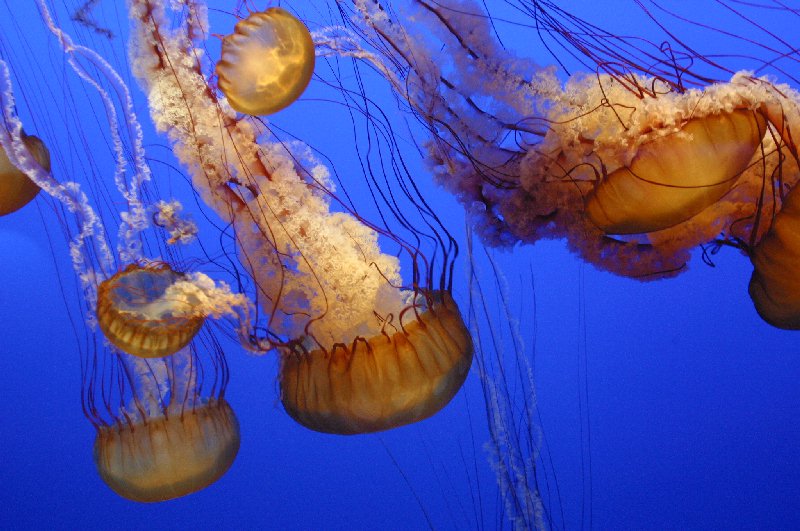
|
|
||||||||||||||||||||||||||||||
|
Website Design + SEO by designSEO.ca ~ Owned + Edited by Suzanne MacNevin | |||||||||||||||||||||||||||||||
